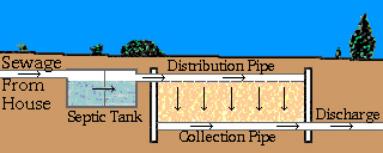
Buried
Do…
- Learn the location of your septic tank and drainfield. Keep a sketch of it handy with your maintenance record for service visits.
- Have your septic system inspected annually and pumped out regularly by a licensed contractor.
- Keep your septic tank cover accessible for inspections and pumpings. Install risers if necessary.
- Call a professional whenever you experience problems with your system, or if there are any signs of system failure.
- Keep a detailed record of repairs, pumpings, inspections, permits issued, and other maintenance activities.
- Conserve water to avoid overloading the system. Be sure to repair any leaky faucets or toilets.
- Divert other sources of water, like roof drains, house footing drains, and sump pumps, away from the septic system. Excessive water keeps the soil in the drainfield from naturally cleansing the wastewater.
Don’t…
- Go down into a septic tank. Toxic gases are produced by the natural treatment processes
in septic tanks and can kill in minutes. Extreme care should be taken when inspecting a
septic tank, even when just looking in. - Allow anyone to drive or park over any part of the system.
- Plant anything over or near the drainfield except grass. Roots from nearby trees or shrubs
may clog and damage the drain lines. - Dig in your drainfield or build anything over it, and don’t cover the drainfield with a hard surface such as concrete or asphalt. The area over the drainfield should have only a grass cover. The grass cover will not only prevent erosion, but will help remove excess water.
- Make or allow repairs to your septic system without obtaining the required health department permit. Use professional licensed septic contractors when needed.
- Use septic tank additives. These products usually do not help and some may even be harmful to your system.
- Use your toilet as a trash can or poison your septic system and the groundwater by pouring harmful chemicals and cleansers down the drain. Harsh chemicals can kill the beneficial bacteria that treat your wastewater.
- Allow backwash from home water softeners to enter the septic system, roots from nearby trees or shrubs may clog and damage the drain lines.
Recirculating
A recirculating sand filter consists of an open filter bed and a pumping chamber following the septic tank. The liquid from the pumping tank is recirculated several times before discharging to a suitable location.
Advantages:
- Only a small area needed for installation
- High water table does not interfere with function
- Discharge site is only 20 to 40 inches below ground level
- Does not depend upon soil to absorb septic tank effluent
Disadvantages:
- High maintenance cost
- Filter bed surface must be kept clear of leaves and grass
- Continuing cost of electricity to run pump, timers and alarms

